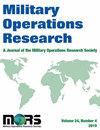A Data-Driven Approach to Beating SAA Out of Sample
IF 0.7
4区 管理学
Q3 Engineering
引用次数: 1
Abstract
A Little Pessimism Goes a Long Way Data-driven optimization is concerned with finding a decision, using data and perhaps a model, that performs well when it is applied on a new unseen data point. Data-driven optimization is challenging because data are limited or the model is wrong or the environment in which the decision is being applied is different from the one in which the training data were collected. Distributionally robust optimization (DRO), a worst case optimization method for finding decisions that are insensitive to model error, can sometimes but not always deliver a decision that has a larger out-of-sample expected reward than the sample average approximation (SAA). “A Data Driven Approach to Beating SAA out of Sample” by Jun-ya Gotoh, Michael Kim, and Andrew Lim shows that if worst case (DRO) solutions fail at this task, then the solution of a best case distributionally optimistic optimization problem will do the job. As good as this sounds, there is a catch: whereas an optimistic decision might beat SAA, the improvement is very modest and comes at the cost of being much more sensitive to model misspecification than both the SAA and the DRO decisions. Moreover, it is easy to make a mistake: it can be difficult to determine with a modestly sized data set whether the best or worst case solution will have the higher expected reward than SAA. In summary, data driven optimization is a trade-off between maximizing the expected reward and controlling the sensitivity of this expectation to model misspecification. When both are considered, a little bit of pessimism goes a long way.打败样本外SAA的数据驱动方法
数据驱动的优化涉及找到一个决策,使用数据,也许是一个模型,当它应用于一个新的看不见的数据点时表现良好。数据驱动的优化是具有挑战性的,因为数据是有限的,或者模型是错误的,或者应用决策的环境与收集训练数据的环境不同。分布式鲁棒优化(DRO)是一种用于寻找对模型误差不敏感的决策的最坏情况优化方法,有时(但并不总是)可以提供比样本平均近似(SAA)具有更大样本外预期奖励的决策。由Jun-ya Gotoh, Michael Kim和Andrew Lim撰写的“打败样本外SAA的数据驱动方法”表明,如果最坏情况(DRO)解决方案在这项任务中失败,那么最佳情况下分布乐观优化问题的解决方案将完成这项任务。尽管这听起来很好,但有一个问题:尽管一个乐观的决定可能会击败SAA,但这种改进是非常温和的,而且代价是对模型错误规范的敏感程度要比SAA和DRO的决定高得多。此外,很容易犯错误:很难用中等规模的数据集确定最佳或最坏情况解决方案是否比SAA具有更高的预期回报。总之,数据驱动的优化是在最大化预期奖励和控制该期望对模型错误规范的敏感性之间的权衡。当考虑到这两点时,一点点悲观主义就会走得很远。
本文章由计算机程序翻译,如有差异,请以英文原文为准。
求助全文
约1分钟内获得全文
求助全文
来源期刊

Military Operations Research
管理科学-运筹学与管理科学
CiteScore
1.00
自引率
0.00%
发文量
0
审稿时长
>12 weeks
期刊介绍:
Military Operations Research is a peer-reviewed journal of high academic quality. The Journal publishes articles that describe operations research (OR) methodologies and theories used in key military and national security applications. Of particular interest are papers that present: Case studies showing innovative OR applications Apply OR to major policy issues Introduce interesting new problems areas Highlight education issues Document the history of military and national security OR.
 求助内容:
求助内容: 应助结果提醒方式:
应助结果提醒方式:


